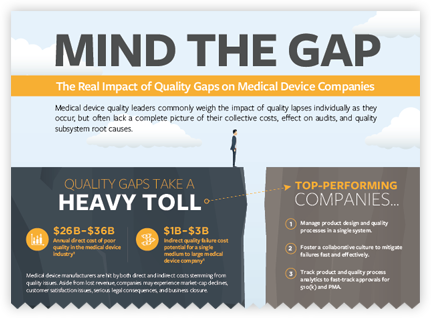Is Product-Centric QMS Right for Your Company?

Most product quality problems are fixed by changing the product record—the product design and the documentation that describes how to manufacture, test, and package the product. When product quality problems are managed in a system independent of the complete product record, fixing identified quality issues is slow. Plus, audits are a challenge, with no automatic link between the problem and the fix.
Product-centric QMS manages quality processes along with product records and product change processes. Managing quality processes within a QMS system fosters a culture of quality throughout your organization. Product companies see significant product quality gains when these quality processes are linked with product records. Product-centric QMS manages your product information, based on a complex bill of material (BOM) that specifies all the components, subassemblies, and associated documents to speed the design, testing, and production of high-quality products.
Working through new product introduction (NPI) processes while navigating FDA regulations and ISO standards requires an integrated approach. Traditional document-centric QMS systems have a major blind spot when it comes to managing the product record. A product development platform (PDP) streamlines product development, management of quality issues, and the resolution of design issues to accelerate delivery of compliant products.
A BRIEF COMPARISON: PRODUCT-CENTRIC VS. DOCUMENT-CENTRIC QMS
How do you know whether product-centric QMS is right for your company? Medical device companies that deal with one or more of the following challenges require a product-centric QMS approach:
- HIGH PRODUCT COMPLEXITY
- PRODUCTION OUTSOURCING
- CORPORATE GROWTH, M&A
- AGGRESSIVE OPERATIONAL GOALS
HIGH PRODUCT COMPLEXITY
Your product is complex if it has diverse components or subsystems that must all work together. Complex products have mechanical, electrical, and software designs typically scattered among workgroup vaults, and each vault is designed to support a team using the same specialized design tool.
Note: Product-centric QMS solutions are designed for medical device companies that design, produce, and deliver complex products. Companies that provide services, like insurance agencies, banks, or restaurants, will get good results from standard, document-centric QMS systems.
PRODUCTION SOURCING
If you use external partners in some or all of your production steps, you may be experiencing quality control and quality assurance challenges. Often your external, or supply chain, partners are located outside your area code, time zone, or even country, so communicating with them is difficult.
Product-centric QMS helps you securely communicate product data across the globe to your partners—at any time of day.
An example of production outsourcing support: If you release a revised sterilization standard operating procedure (SOP), your partner gets notified and uses their valid credentials to download that information immediately. An activity log shows you that the partner has downloaded the most recent version of the SOP.
Product-centric QMS enables secure collaboration with supply chain partners, so you leverage their specialized knowledge and experience into product improvements. An example is a manufacturability enhancement. A contract manufacturer follows your instructions to assemble parts into a final product. But over time they find bottlenecks in the manufacturing line and recommend reconfiguring the product so it’s easier to build. This change results in higher volumes with the same production line. Product-centric QMS enables these collaborative efforts, which benefit both you and your supply chain partners.
CORPORATE GROWTH, M&A
Corporations grow to provide more complete solutions and obtain cost savings. Growth comes from developing more products internally or obtaining them through mergers and acquisitions.
With more products or product lines, product-centric QMS accelerates time to market through easier design reuse and streamlined product processes. Product-centric QMS enables design reuse through flexible searching for a complete product record and BOM redlining to describe the changes.
For corporate mergers and acquisitions, use product-centric QMS to standardize, normalize, integrate, and scale quality and product processes. For example, the customer complaint process in product-centric QMS is integrated, transparent, and accelerated. All stakeholders understand the benefits of keeping customer service high during an often tumultuous time.
OPERATIONAL GOALS
Meeting operational goals contributes to a company meeting profit goals through improved revenue and cost savings. Examples include:
- Faster time to market
- Lower cost of goods sold
- Improved product quality
The impact of meeting these goals can be dramatic.
For revenue gains, product-centric QMS accelerates time to market for new products and for new features. Product-centric QMS is an integrated system that offers streamlined processes and enhanced communication. Product-centric QMS, unlike traditional QMS, is architected for easy integration with systems like CAD and ERP.
For cost savings, product-centric QMS helps purchasing and manufacturing realize measurable savings. Purchasing gets early access to parts and subassemblies that need to be sourced to begin finding the best supplier. In addition, procurement aggregates forecasted demand for standard parts and use that information to negotiate lower prices based on higher volumes. Manufacturing has instant access to the latest, released revision of instructions and procedures, such as assembly instructions and test procedures.
Finally, the improved product quality from the streamlined, integrated quality processes dramatically saves costs due to fewer rework orders, recalls, and field replacements.
CONCLUSION
Most product companies experience these challenges. You can meet these challenges with a comprehensive PDP that provides product-centric QMS. For more information, read the “7 Principles of Product-Centric Quality Management” eBook for more information about product-centric QMS and check out our guide to QMS software.



